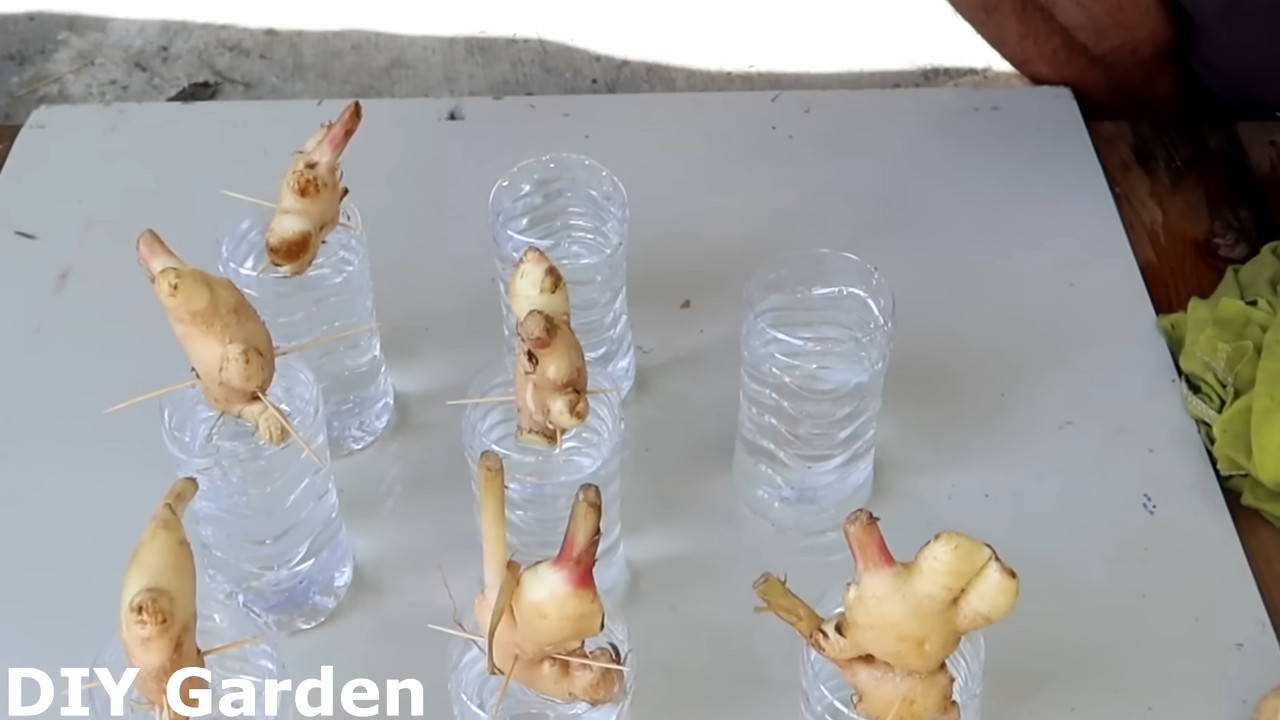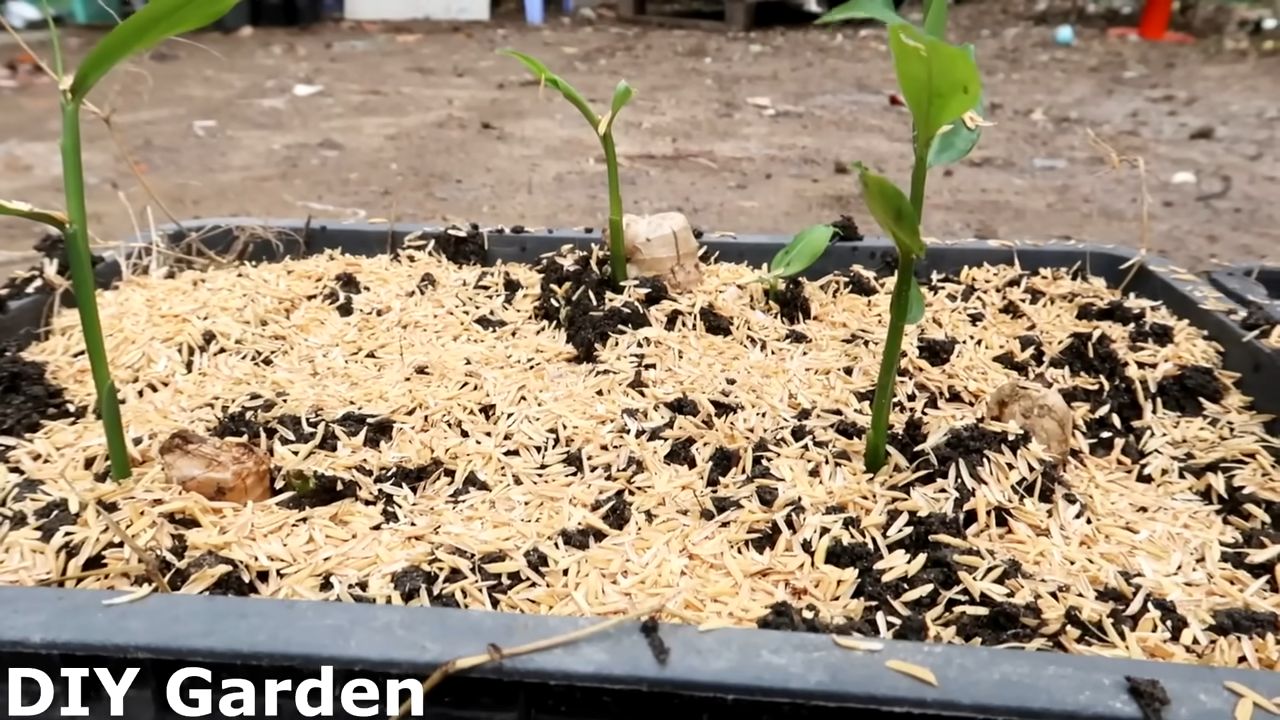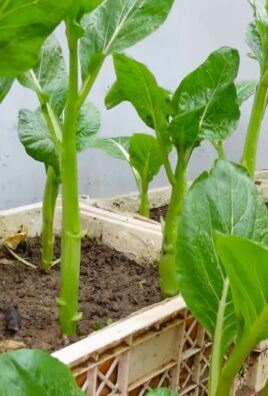Growing Ginger at Home might seem intimidating, but trust me, it’s easier than you think! Have you ever been in the middle of cooking a delicious stir-fry and realized you’re completely out of fresh ginger? Or perhaps you’re tired of buying ginger from the store, only to have it shrivel up in your fridge before you can use it all? Well, I’m here to tell you that you can say goodbye to those frustrations!
Ginger, with its fiery zest and incredible health benefits, has been a staple in Asian cuisine and traditional medicine for centuries. From ancient Ayurvedic practices to modern-day culinary creations, ginger’s versatility is undeniable. But did you know you can easily cultivate this amazing rhizome right in your own home?
This DIY guide will walk you through the simple steps of growing ginger at home, even if you don’t have a green thumb. We’ll cover everything from selecting the right ginger root to providing the ideal growing conditions. Imagine the satisfaction of harvesting your own fresh ginger whenever you need it, adding a burst of flavor to your meals and enjoying its numerous health benefits. Plus, it’s a fantastic way to connect with nature and add a touch of greenery to your living space. So, let’s get started and unlock the secrets to a thriving ginger harvest!

Growing Ginger at Home: Your Simple DIY Guide
Hello, fellow gardeners! Have you ever wondered how you can easily grow that spicy, healthy ginger you love right at home? I’ll show you how it’s done! It’s easier than you think, and you’ll soon be able to harvest your own fresh ginger. Let’s get started!
What You’ll Need: The Ingredients for Your Ginger Success
Before we begin, make sure you have everything you need. Here is a list:
- A piece of ginger root (rhizome): It’s best to get this from an organic store, as conventional ginger is often treated with growth inhibitors. Make sure the root has plump “eyes” (buds).
- A pot: It should be at least 30 cm (12 inches) wide and deep to give the ginger root enough space to grow.
- High-quality potting soil: Good drainage is important! Ginger does not like waterlogged soil. I recommend a mixture of potting soil, compost, and a little perlite or sand.
- Water: For watering, of course!
- A sunny location: Ginger loves warmth and light, but not direct midday sun.
- Patience: Ginger takes time to grow.
Step-by-Step Guide: How to Plant Your Ginger
Now let’s get down to business! Follow these steps to successfully plant your ginger:
- Prepare the ginger root: If your ginger root has several “eyes,” you can cut it into pieces. Each piece should have at least one eye. Let the cut surfaces air-dry for a few days to prevent rot. This is optional, but I find it increases the chances of success.
- Prepare the pot: Fill the pot with your potting soil mix. Leave about 5 cm (2 inches) of space at the top.
- Plant the ginger root: Place the ginger root on the soil with the eyes facing up. Then cover it with about 2-5 cm (1-2 inches) of soil. Gently press the soil down.
- Water: Water the soil thoroughly until it is moist but not soaked.
- Choose the right location: Place the pot in a warm, bright spot, but avoid direct midday sun. An east- or west-facing window is ideal.
Caring for Your Ginger: How to Keep it Happy and Healthy
After planting, proper care is crucial. Here are my tips:
- Watering: Keep the soil moist, but not wet. Water when the top layer of soil feels dry. Avoid waterlogging, as this can lead to root rot.
- Fertilizing: Ginger is a heavy feeder. Fertilize it every two weeks with an organic liquid fertilizer. I like to use compost tea.
- Temperature: Ginger loves warmth. The ideal temperature is between 20 and 30 degrees Celsius (68-86°F).
- Humidity: Ginger likes high humidity. Spray the leaves regularly with water, especially in winter when the heating makes the air dry.
- Repotting (optional): If your ginger becomes too large for its pot, you can transplant it into a larger one.
Harvest Time: Your Homegrown Ginger
After about 8-10 months, it’s time for the harvest!
- When to harvest? You’ll know your ginger is ready for harvest when the leaves turn yellow and die back.
- How to harvest? Carefully dig out the ginger root. You can either harvest the whole root or cut off a part of it and replant the rest.
- Storage: Fresh ginger keeps in the refrigerator for about 2-3 weeks. You can also freeze or dry it.
Problem Solving: What to Do When Something Goes Wrong?
Even when growing ginger, problems can occur. Here are some common problems and how you can fix them:
- Yellow leaves: Can be a sign of overwatering, under-fertilizing, or too little light. Check your care routine and adjust it accordingly.
- Root rot: Is caused by waterlogging. Ensure good drainage and water less.
- Pests: Ginger is relatively resistant to pests, but occasionally aphids or spider mites may appear. Combat them with a natural insecticide or a soap solution.
Additional Tips and Tricks: For an Extra Green Thumb
Here are a few more tips that can help you optimize your ginger cultivation:
- Rooting ginger in water: You can also let the ginger root sit in a glass of water first until roots form. This speeds up the growth process.
- Compost tea: Compost tea is an excellent fertilizer for ginger. It contains many nutrients and promotes growth.
- Mulching: Mulch the soil around the ginger with straw or leaves. This helps to retain moisture in the soil and suppress weeds.
- Different varieties: There are different ginger varieties that vary in taste and appearance. Try different types to find your favorite.
- Ginger in winter: In winter, it can be difficult to provide the right temperature and humidity for ginger. Place the pot in a warm spot and spray the leaves regularly with water. A grow light can also help.
Ginger in Hydroponics: An Alternative Growing Method
If you don’t want to use soil, you can also grow ginger in hydroponics. Here is a brief guide:
- The system: You will need a hydroponic system, e.g., a Kratky system or a Deep Water Culture (DWC) system.
- The nutrient solution: Use a special nutrient solution for hydroponics. Make sure it contains all the important nutrients for ginger.
- The ginger root: Place the ginger root in the hydroponic system so that the roots are submerged in the nutrient solution.
- Light and temperature: Place the system in a bright, warm location.
- Care: Regularly check the pH of the nutrient solution and adjust it if necessary. Change the nutrient solution every few weeks.
Ginger as a Houseplant: A Decorative and Useful Eye-Catcher
Ginger is not only useful but also an attractive houseplant. The green leaves bring life to any room.
- Decorative value: The upright, lance-shaped leaves of ginger are very decorative.
- Air purification: Ginger can filter pollutants from the air and thus improve the indoor climate.
- Aromatherapy: The leaves of ginger emit a pleasant scent that is calming and relaxing.
Ginger in the Kitchen: Versatile and Healthy
Ginger is a real superfood and versatile in the kitchen.
Pickled ginger: Pickled ginger is a popular accompaniment to sushi.
Tea: Ginger tea is a popular home remedy for colds and digestive problems.
Cooking: Ginger adds a spicy note to many dishes, e.g., curries, soups, and stir-fries.
Baking: Ginger can also be used in cakes, cookies, and bread.
Smoothies: A small piece of ginger in a smoothie provides an extra kick of freshness.

Conclusion
So, there you have it! Growing ginger at home is not only achievable, but it’s also a deeply rewarding experience that connects you to the food you consume in a tangible way. Forget those bland, store-bought rhizomes that have been sitting on shelves for weeks. Imagine the vibrant, spicy flavor of freshly harvested ginger, ready to elevate your culinary creations and soothe your senses.
This DIY trick is a must-try for several compelling reasons. First, it’s incredibly cost-effective. A single piece of ginger from the grocery store can yield a bountiful harvest, saving you money in the long run. Second, you have complete control over the growing process, ensuring that your ginger is free from harmful pesticides and chemicals. Third, and perhaps most importantly, the flavor of homegrown ginger is simply unmatched. It’s more intense, more aromatic, and more alive than anything you can buy in a store.
But the beauty of growing ginger at home lies in its adaptability. Feel free to experiment with different varieties of ginger, such as the fiery ‘Canton’ or the milder ‘Yellow’ ginger. You can also adjust the growing conditions to suit your climate. If you live in a colder region, consider growing your ginger in containers that can be moved indoors during the winter months. For those in warmer climates, providing some afternoon shade can prevent the leaves from scorching.
Consider these variations to personalize your ginger-growing journey:
* Ginger Tea Garden: Plant ginger alongside other herbs like mint, lemongrass, and turmeric to create a dedicated tea garden. This allows you to harvest fresh ingredients for soothing and flavorful herbal infusions.
* Ginger Bonsai: With careful pruning and training, you can cultivate a ginger plant into a unique and eye-catching bonsai specimen. This adds a touch of exotic beauty to your indoor space.
* Ginger Companion Planting: Plant ginger near tomatoes, peppers, and other vegetables to deter pests and improve soil health. Ginger’s natural insect-repelling properties can benefit your entire garden.
Don’t be intimidated by the prospect of growing your own ginger. It’s a surprisingly easy and forgiving process, even for beginner gardeners. With a little patience and attention, you’ll be harvesting your own supply of fresh, flavorful ginger in no time.
We wholeheartedly encourage you to give this DIY trick a try. It’s a simple, sustainable, and satisfying way to enhance your culinary experience and connect with nature. Once you’ve harvested your first batch of homegrown ginger, we’d love to hear about your experience! Share your photos, tips, and recipes with us in the comments below. Let’s build a community of ginger-growing enthusiasts and inspire others to discover the joys of homegrown goodness. Let us know if you found this guide on growing ginger at home helpful!
Frequently Asked Questions (FAQ)
What kind of ginger should I use to start growing?
You can use any fresh ginger rhizome from the grocery store, but look for pieces that are plump, firm, and have visible “eyes” (small buds). Organic ginger is often a better choice, as it’s less likely to have been treated with growth inhibitors. Avoid ginger that is shriveled, moldy, or has soft spots.
How long does it take to grow ginger from start to harvest?
It typically takes around 8-10 months from planting to harvest mature ginger. However, you can start harvesting small pieces of ginger after about 4 months for culinary use. The longer you let it grow, the larger and more flavorful the rhizomes will become.
What is the best soil for growing ginger?
Ginger thrives in well-draining, fertile soil that is rich in organic matter. A mix of potting soil, compost, and perlite or vermiculite is ideal. The soil should be slightly acidic to neutral (pH 6.0-7.0). Good drainage is crucial to prevent root rot.
How much sunlight does ginger need?
Ginger prefers partial shade, especially in hot climates. Direct sunlight can scorch the leaves. Aim for about 2-5 hours of indirect sunlight per day. If growing indoors, place your ginger plant near a bright window but away from direct sunbeams.
How often should I water my ginger plant?
Keep the soil consistently moist, but not waterlogged. Water thoroughly when the top inch of soil feels dry to the touch. Reduce watering during the winter months when the plant is dormant. Overwatering can lead to root rot, so ensure good drainage.
What are the signs of overwatering or underwatering ginger?
Overwatering signs include yellowing leaves, wilting, and a musty smell from the soil. Underwatering signs include dry, crispy leaves and stunted growth. Adjust your watering schedule accordingly based on these signs.
Do I need to fertilize my ginger plant?
Yes, ginger benefits from regular fertilization, especially during the growing season (spring and summer). Use a balanced liquid fertilizer diluted to half strength every 2-3 weeks. You can also amend the soil with compost or other organic matter to provide slow-release nutrients.
Can I grow ginger indoors?
Absolutely! Growing ginger indoors is a great option, especially if you live in a colder climate. Choose a pot that is at least 12 inches in diameter and provide adequate drainage. Place the pot in a warm, bright location and maintain consistent moisture.
What pests and diseases affect ginger plants?
Ginger plants are relatively pest-resistant, but they can be susceptible to aphids, spider mites, and mealybugs. Inspect your plants regularly and treat any infestations with insecticidal soap or neem oil. Root rot is the most common disease, which can be prevented by ensuring good drainage and avoiding overwatering.
How do I harvest ginger?
To harvest ginger, gently dig around the plant and lift the rhizomes from the soil. You can harvest the entire plant or just take a few pieces as needed. Wash the harvested ginger and store it in a cool, dry place. Fresh ginger can be stored in the refrigerator for several weeks or frozen for longer storage.
Can I regrow ginger from the pieces I harvest?
Yes, you can replant a piece of the harvested ginger rhizome to start a new plant. Choose a piece with visible “eyes” and follow the same planting instructions as before. This is a great way to continuously propagate your ginger plants.
Is ginger good for my health?
Ginger has numerous health benefits. It is known for its anti-inflammatory, antioxidant, and digestive properties. It can help relieve nausea, reduce muscle pain, and boost the immune system. Incorporating fresh ginger into your diet is a delicious and healthy way to improve your overall well-being.




Leave a Comment